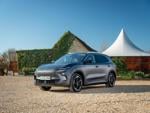Review
From being the mainstream model, an upper-medium car is now neither a premium brand attracting label lovers, an MPV with lots of seats or a lower- medium hatch which is more usefully compact. And a high volume car is in danger of being neither here nor there – a bland nonentity.
So Peugeot has gone down the route of being more controversial with the 407. It accepts that some people won't like the look of it; and that the SW is not a big load estate workhorse; and that the saloon may not have the most internal space in its class.
So what we have here is a volume car designed to take a greater share of an imploding sector through being one that stands out enough to be noticed and chosen for its character rather than fleet utilitarianism.
Peugeot reckons to sell 27,000 407s in a full year in the UK, with 70% of those fleet registrations. In its best year, the 406 sold 48,000, in a sector twice as large, so even by the most simplistic maths that's a larger share with this car.
The reason for that optimism, Steve Harris, Peugeot's fleet director reckons, is that the car will attract more user-choosers wanting a product that has a little less conformity with other volume players such as the Ford Mondeo or Vauxhall Vectra.
While Peugeot is refreshingly honest in admitting it is a volume player (it seems in some quarters to have become a dirty word thanks to many customers' obsessions with premium badging), it reckons the car will do more business through leasing companies in the vital and rather profitable user-chooser market, rather than in large bulk fleet deals.
As a result, the firm has done a lot of groundwork in the leasing industry. It has taken the step of putting together a roadshow programme that will take the car round the leasing firms, showing it to as many people as possible, so that when customers are on the phone, the 407 will be at the forefront of account managers' minds.
By far the most popular models will be the diesel-engined variants, with two available from launch in 136bhp 2.0-litre and 110bhp 1.6-litre guise.
Harris reckons they could account for as many as 80% of sales in the fleet sector and it's not hard to see why with Euro IV compliancy and emissions of 155g/km of CO2 or less and fuel consumption in the late 40mpg or above.
Prices start at £14,750 on-the-road for the S, although Peugeot believes that the SE will be the most popular fleet specification. That gets CD player, digital climate control and seven airbags (including a steering column airbag).
The residual value forecasters reckon that the car will hold a value marginally above Vectra or Mondeo, but below Passat or Avensis, and again Peugeot is being pragmatic here.
Executives believe they have a fantastic new product, but they aren't going overboard: they recognise a brand entrenched in the volume market when they see one and there's no inclination to go gunning for Honda or any of the other semi-premium brands.
What the firm really wants to do is get across how dynamically impressive the car is. Peugeots historically have had the reputation for being a good drive, although this has been lost somewhat over the past few years.
The 407 aims to pick up the mantle again, with a new suspension system partially based on Peugeot racing saloon of the late 1990s, large wide tyres across the range (16in wheels are the smallest available) and huge brakes with class-leading stopping distances.
The other central theme is safety. The 407 has one of the wobbliest bonnets I've ever seen. You can push it down a significant distance, and it pops back into place again. That's to give pedestrians the best possible impact protection around.
It also has seven airbags as standard across the range, and a hi-tech front-end designed to channel and dissipate impact forces more effectively. Peugeot reckons this car will walk a Euro NCAP five star rating, and has been designed to pass with flying colours should the tests get even more strenuous.
Behind the wheel
The first impression inside the 407 is one of space. Outside it looks as though the car is all bonnet. Inside, the front passengers are presented with a wide vista across the dashboard and through the deep front window.
There is also lots of shoulder and knee room, and it's easy to get a comfortable seating position, particularly as the steering wheel telescopes out. Back seat passengers aren't as well accounted for though. There's not much headroom while leg room is at best average for the sector.
Because of the shape of the roofline and the doors, getting in and out, both front and back, is not as easy as it should be: there is not much headroom getting in the front, and not much legroom at the back, where the aperture is narrow low down.
Depending on the material, the seats are either nicely sculpted and supportive or horrible. The leather and part leather seats are excellent for holding driver and passenger in, but the velour seats are spongy and antiquated: my gran had a sofa made of this stuff in the seventies. The console layout and switchgear is a marked improvement and the dials are all rimmed in silver and look very natty.
I'm not yet sold on the visibility in this car though. The A pillars seem intrusive, although we were in left-hand drive cars on twisty roads, the unfamiliarity of which could have heightened the sensation, and only by inching round a tight multi-storey car parking space will we discover if the 407's long snout and huge front overhang will become a magnet for dings.
There were three engines at launch: the 2.0-litre HDi, 2.2-litre petrol and the 3.0-litre V6 petrol. It's worth getting the 3.0-litre V6 out of the way first. One, because it's not a fleety engine and two, because it's not very good.
It is no quicker than the diesel, in real terms it sounds no better than the smaller petrol, it only comes as an automatic and as a result its emissions are too high at 233g/km.
The other two units have much more going for them. The diesel, with a six speed manual box is not lightning fast (illustrating just how weedy the V6 is) despite 136bhp, but this is a big car and in that context it does a good job of hauling it around at decent rates.
At start-up, there was a fair amount of vibration throughout the cabin, but this disappeared soon enough and as a motorway cruiser, it is no less refined than the petrol.
The gearbox does a workmanlike job without having the finesse of a car like the Honda Accord, and all in all this is probably the combination to have.
The 2.2 petrol unit shouldn't be discounted though. It makes all the requisite sporty noises and isn't much slower than the larger V6.
As for handling, it corners with phenomenal amounts of grip. It hugs a line faithfully for such a large car and there is almost no body roll at all.
It would seem that the new front suspension system does a great job of getting as much area of these big tyres into contact with the road as possible. The steering is fairly sharp as well, but not in Mazda6 territory – although any feel is masked by the huge tyres.
But I'm less convinced by the ride quality, and to be honest, the jury is out on this until we get it back to Blighty on roads we know.
The road surfaces in Portugal are a combination of European Union funded Grand Prix slickness, while others seem to have been flattened by one old man and a spade.
On the flat stuff the 407 felt ultra composed and planted – on others it felt antagonised and unsettled by undulations of big and small variety, and never much in between.
Driving verdict
The 407 is a decent all round package that handles well, is very safe and, to most eyes, looks good. It should be a useful fleet performer.














